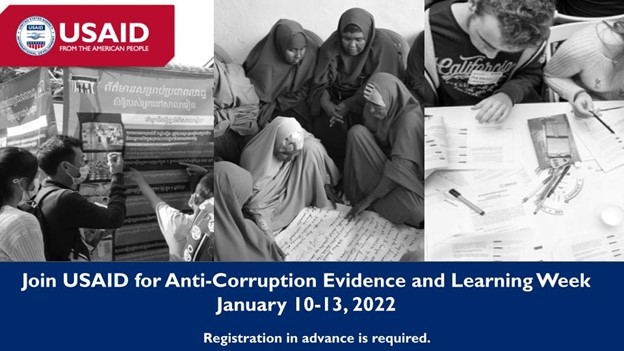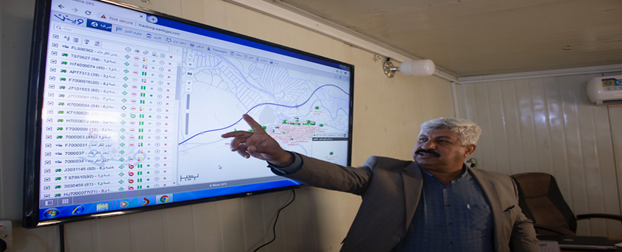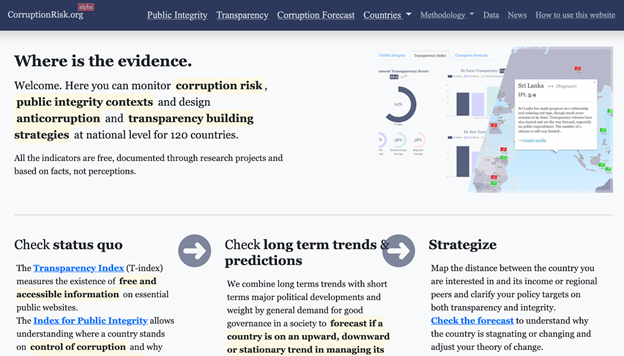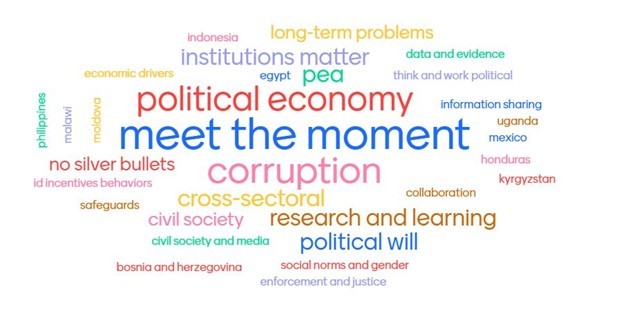|
DRG Learning Digest - Anti-Corruption
February 2022
|
|
 Left to Right: An information campaign on citizen rights through a mobile loudspeaker at Srea Village in Cambodia (Photo: Heng Leng, Innovations for Social Accountability in Cambodia); Somali women from conflicting clans come together to learn, decide, and plan the future of their district (Photo: Mohamed Abdullah Adan, Pact); Fourth annual Ukrainian Anti-corruption School developed in partnership by the United Nations Development Programme and USAID. (Photo: Support for Anti-Corruption Champion Institutions [SACCI])
Anti-Corruption Evidence and Learning in Action
Anti-corruption is one of USAID’s and the U.S. government’s top priorities, most recently highlighted in the release of the first-ever U.S. Strategy on Countering Corruption and the creation of the USAID Anti-Corruption Task Force (ACTF). This prioritization builds on the Agency’s significant work on the issue over the last three decades, with the ACTF tasked with strengthening, elevating and integrating anti-corruption across USAID’s work. To highlight what we currently know, what we are starting to understand, and what we need to learn to effectively combat corruption globally, the ACTF and the Center for Democracy, Human Rights, and Governance (DRG Center) co-hosted USAID’s first-ever Anti-Corruption Evidence and Learning Week (AC E&L Week) from January 10-13, 2022.
More than 450 participants joined from USAID, other U.S. government agencies, academia, think tanks, and implementing partners, among others. The week’s learning will inform the ACTF’s anti-corruption programmatic guidance, new anti-corruption program design and adaptation, future anti-corruption learning agendas, implementation of the new U.S. strategy, and bold new anti-corruption programs to be developed during the Summit for Democracy Year of Action. As USAID Deputy Administrator for Policy and Programming, Isobel Coleman, underscored in her keynote remarks, it is essential that USAID’s anti-corruption efforts draw on evidence and learning in order to maximize impact.
This edition of the DRG Learning Digest highlights learning from the week’s events:
-
Leveraging Learning Tools for Anti-Corruption Programming: While a wealth of data, analytical tools, and indicators exist for anti-corruption programming, these need to be made more readily accessible to practitioners.
-
Mining Existing Anti-Corruption Evidence: There is a strong anti-corruption evidence base on issues ranging from institutional approaches to actions by non-governmental actors. These existing data sets need to be connected to understand the system and broader dynamics around corruption.
-
Building on Emerging Anti-Corruption Evidence: Anti-corruption practitioners are learning more on topics ranging from transnational corruption to the role of social norms in countering it. Additional analysis is needed to unpack these emerging trends and responses.
Access resources from AC E&L Week here or at links throughout this edition. For more information on USAID’s ACTF, please visit www.usaid.gov/anti-corruption or email actf@usaid.gov. Please also make use of DRG Evidence and Learning Team resources! (See text box at the end.)
|
|
LEVERAGING LEARNING TOOLS FOR ANTI-CORRUPTION PROGRAMMING
What evidence and learning tools and resources are available for anti-corruption practitioners? In The Value of Evidence and Learning for Anti-Corruption Approaches, panelists urged practitioners to draw on evidence, know-how, and “know-who” to inform anti-corruption programming. The session highlighted a number of resources to help practitioners access existing evidence, including the Global Integrity and School of Oriental and African Studies (SOAS) Anti-Corruption Evidence (ACE) programs, U4 Anti-Corruption Resource Centre resources, and the DRG Learning, Evidence, and Analysis Platform (LEAP). In Leveraging USAID Learning Agendas for Anti-Corruption Impact, panelists reviewed USAID anti-corruption learning activities such the emerging Agency Learning Agenda, DRG Learning Agenda research on transparency and accountability, and forthcoming DRG Learning Agenda research on how we can foster anti-corruption reform where political will is weak.
During a session on Political Economy Analysis: Evidentiary Tool Deep Dive, experts challenged anti-corruption practitioners to use tools like political economy analysis to account for political dynamics and incentives at play in their contexts. Independent consultant, Florencia Guerzovich, highlighted learning on politically-smart support for anti-corruption change agents and the use of “mid-level theory” for developing and testing theories of change for social accountability. Alina Rocha Menocal from the Overseas Development Institute (ODI) outlined key evidence-based considerations for nuanced anti-corruption approaches, including that some forms of corruption are more pernicious than others, so in order to design anti-corruption programming it is crucial to understand how rents from corruption are managed and distributed.
In a session on Anti-Corruption Measurement and Evaluation: Tracking Problems and Progress, panelists stressed the need to be clear about our objectives when we measure change in corruption, think critically about what change looks like in a given context, and leverage the expertise of local partners. Johannes Tonn from Global Integrity highlighted a number of resources, including the Africa Integrity Indicators and the Unbundled Corruption Index. He also recommended incorporating metrics through USAID’s Collaborating, Learning, and Adapting approach. Paola Pavlenko from USAID/Ukraine highlighted early impact from anti-corruption programming in Ukraine’s health sector and reviewed findings from a performance evaluation. Finally, Cheri-Leigh Erasmus detailed a contribution tracing evaluation used to gauge the impact of Accountability Lab’s Integrity Icon program.
 Abdulsalam Ibrahim Al Akaiedi, machinery fleet manager of the Ramadi Municipality Directorate in Iraq’s Anbar Province, traces the real-time location of a garbage truck installed with a GPS system as it goes through its route. (Photo: Alhamzah Jawad, Iraq Governance and Performance Accountability/Takamul Project)
|
|
MINING EXISTING ANTI-CORRUPTION EVIDENCE
What is the existing data and evidence on anti-corruption approaches? During a session on Mapping the Evidence, Dr. Brigitte Seim from the University of North Carolina reviewed the latest evidence and gaps in experimental research about corruption control, pointing to effective approaches such as the combination of top-down and bottom-up auditing with sanctions. The session also previewed a forthcoming Governance Evidence Gap Map on the DRG Learning, Evidence, and Analysis Platform (LEAP). In Evidence on Cross-Sectoral Anti-Corruption Approaches, experts from the health, water, infrastructure, and natural resource management sectors exchanged evidence on promising approaches in their sectors. Barbara Scheiner from Water Integrity Network highlighted a Water and Sanitation Sector Integrity Risk Index (WIRI) and an Integrity Assessment Tool for Water and Sanitation Utilities. Alex Gilles from Natural Resource Governance Institute shared a tool for diagnosing corruption in the extractive industry sector. Finally, Rebecca Turner from USAID’s Global Health Bureau shared resources for identifying corruption in health supply chains.
In Evidence on the Effectiveness of Institutional Anti-Corruption Approaches, Phyllis Dininio from Management Systems International shared analysis of anti-corruption efforts in Sub-Saharan Africa and the Middle East and North Africa (link only accessible to USAID personnel). This evidence indicates that while some interventions – including administrative reform, simplification, e-governance, and public financial management – tend to have a more consistent impact over a range of contexts, other interventions need to be tailored to the specific local manifestations of corruption. Alina Mungiu-Pippidi from the Hertie School noted the overwhelming evidence that in almost all environments transparency helps reduce opportunities for corruption, but important enablers, such as a free and independent press and judicial independence, need to be in place to make use of that information and hold corrupt actors accountable. To that end, she highlighted a new corruption risk tool, publications from the European Research Centre for Anti-Corruption and Statebuilding, data from the European Public Accountability Mechanisms, and a paper on seven steps to control corruption. In Evidence on the Impact of Non-Governmental Actors, panelists reviewed evidence regarding the successes and challenges of civil society, media, and social movements in exposing corruption and facilitating reform. Claudia Baez Camargo from the Basel Institute shared research on informal corruption networks and how networks of non-governmental actors can respond. Sheila Coronel from Columbia University detailed research on the key role of independent media in addressing corruption.
On the third day of Anti-Corruption Evidence and Learning Week, USAID staff exchanged and reflected on programmatic learning (see resources here; link only accessible to USAID personnel). During a session on Evidence and Learning in USAID’s Anti-Corruption Programming, the ACTF shared a high-level review of its recent internal stocktaking exercise, which identified the need for additional and more flexible resources to address corruption, renewed technical integration guidance, and better data and information-sharing. Across a series of concurrent Mission Spotlight sessions, colleagues from USAID Missions in every region shared key innovations, including ways to: integrate anti-corruption across Country Development Cooperation Strategies, learn and adapt during political openings, leverage local partners’ knowledge, and cooperate regionally. A session on Anti-Corruption Safeguards, Risks, and Measurement shared approaches and tools for corruption/fraud reporting, safeguarding, and risk assessments.
 Screenshot of the homepage at dev.corruptionrisk.org.
|
|
BUILDING ON EMERGING ANTI-CORRUPTION EVIDENCE
What kind of new evidence is emerging in the anti-corruption field? During a session on New Learning on Transnational Corruption, experts discussed new data on corruption and transnational organized crime in the Global Organized Crime Index. In extractive industries and other key sectors, evidence indicates that beneficial ownership standards and other transparency measures can help address systemic transnational corruption. In Building Resilience to Strategic Corruption, panelists explored the parameters of strategic corruption and the intersection between key industries and illicit financial flows, as well as considerations for building resilience to strategic corruption.
During a session on Corruption, Social Norms, and Social and Behavior Change, speakers highlighted how social norms can drive and enable either corrupt or accountable behaviors. They recommended context-aware interventions that pay attention to the message, messengers, and audience. Research presented by Dr. Nic Cheeseman from the University of Birmingham concluded that many anti-corruption messages largely fail to discourage the decision to bribe because they provide information on how widespread corruption is, which inadvertently encourages people to go with the flow. Instead, the evidence indicates messaging should create positive impressions that peers are addressing corruption, to encourage others to join in resisting paying bribes. Cheyanne Scharbatke-Church, from the Tufts University Corruption, Justice, and Legitimacy Program, shared a systems-based process to understand corruption in fragile states and highlighted practitioner resources on identifying social norms as drivers of corruption.
 Word cloud with key reflections from USAID Anti-Corruption Evidence and Learning Week (Image: USAID ACTF)
|
|
|
Welcome to the DRG Learning Digest, a newsletter to keep you informed of the latest learning, evaluation, and research in the Democracy, Human Rights and Governance (DRG) sector. Views expressed in the external (non-USAID) publications linked in this Digest do not necessarily represent the views of the United States Agency for International Development or the United States Government.
Don't forget to check out our DRG Learning Menu of Services! (Link only accessible to USAID personnel.) The Menu provides information on the learning products and services the Evidence and Learning Team offers to help you fulfill your DRG learning needs. We want to help you adopt learning approaches that emphasize best fit and quality.
The Evidence and Learning Team is also excited to share our DRG Learning, Evidence, and Analysis Platform (LEAP) with you. This Platform contains inventories of programmatic approaches and indicators, evidence gap maps, and data portraits - all of which can be very useful in DRG activity design, implementation, evaluation, and adaptation. Some of these resources are still being built, so check back frequently to see what has been newly added.
We also want to share our DRG Learning Harvest with you! (Link only accessible to USAID personnel.) This is a searchable database of DRG learning products, including summaries of key findings and recommendations, drop-down menus to easily find documents related to a particular country or program area, and links to the full reports on the DEC.
Our friends at the Varieties of Democracy (V-Dem) Institute are also seeking to expand their research partnership with USAID on the complex nature of democracy by inviting research questions from you for V-Dem to work on. If there's a DRG technical question you've been wondering about, please email the Evidence and Learning Team at ddi.drg.elmaillist@usaid.gov.
|
|
|
|
|